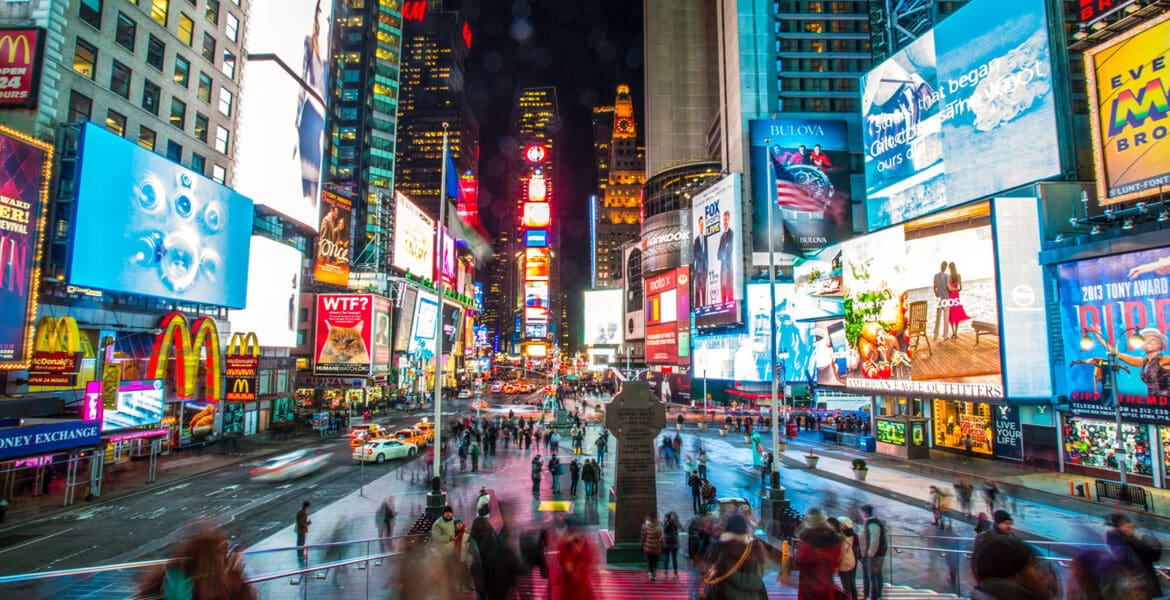By Matt Oliver, VP Demand, Hivestack
With many traveling less and primarily working from home during the pandemic, advertisers pivoted their marketing approach away from Out of Home (OOH). However, with the outside world opening its doors, there is a healthy appetite to move the budget back to the channel, in particular media plans that employ programmatic digital out of home (DOOH).
The US has 9,600 digital billboards and over 1,250,000 digital place-based ads. The scale of this inventory means that brands both large and small can take advantage of programmatic DOOH as part of their marketing mix. With this vast amount of supply, understanding how programmatic DOOH is well placed to activate campaigns at the right locations, for the right audience and at the right time, while effectively showcasing return on investment is key to making the best use of your ad budget.
Access to Large Inventories and Efficient Ad Serving
When most think of DOOH screens in the US, the first images that might come to mind are the colorful, breathtaking 3D displays in the bright lights of Times Square. But DOOH inventory can come in many different forms, from large billboards to smaller screens at convenience store checkouts or on bus shelters.
Programmatic DOOH buying methods use a demand side platform (DSP) to programmatically buy, sell and deliver ad inventory in real-time. The biggest advantage is the ease of activation, efficiency and scale allowed by buying DOOH inventory from multiple sources through one platform. When it comes to serving an ad, campaign creatives aren’t scheduled in a traditional loop based model, instead, they are activated dynamically according to pre-set parameters before the campaign is set live and optimized in real-time.
As a result, brands and agencies don’t have to worry about scale and flexibility of campaigns or inventory availability. In addition, programmatic DOOH campaigns can be adjusted, optimized or paused in-flight allowing for greater control of media budgets.
Let the Data Dictate the Buying Strategy
Although brands may be tempted to create large scale screen takeovers to make an impact, this type of activation may not always be needed to meet a campaign’s goals. Similarly, if a campaign aims to target New Yorkers, running ads in tourist-heavy areas like Times Square might not be the most effective use of budget. So, how should advertisers go about setting up an effective DOOH buying strategy that targets the right audience?
Programmatic DOOH is inherently data-driven. The technology enables measurable, highly-targeted campaigns by utilizing anonymous mobile ID data to learn and understand audience movement patterns. Ads are activated in real-time and at the right place based on this learnt audience behavior by leveraging offline characteristics such as affinity, personas, footfall density and dwell-time.
For instance, if a Hollywood movie production house wants to advertise its latest movie, a programmatic DOOH campaign could not only target audiences who have recently been to the movie theater where the show is playing but also those who have watched similar genre television shows at home or visited other nearby movie theaters.
Additionally, through programmatic DOOH, unique moment-based triggers can be activated to capture the attention of the right audience with contextually relevant creative. For example, on days with high pollen counts, a pharmaceutical company could drive sales by activating custom messaging around its latest allergy medication. These triggers can be wide ranging, from weather to traffic density, to specific sporting events or holidays
DOOH inventory isn’t one size fits all and targeting shouldn’t be either. Instead, through its data capabilities, programmatic DOOH will dictate the buying strategy to serve ads on the right screen, at the right time.
Measuring Your Ad Performance
At the end of a campaign, programmatic DOOH has the measurement capabilities to effectively showcase how your campaign performed. Consumer intentions, awareness and even footfall traffic can be measured in a consumer data privacy secure manner. From the first time a customer passes a DOOH display to when they cross the threshold into a physical store, brands can track consumers through the sales funnel. Even brands without brick and mortar locations will still be able to measure effectiveness by placing audience behavior metrics against specific KPIs for online footfall.
With the wealth of available DOOH inventory in the US, it is no wonder that the channel is projected to reach a market size of US$11.310 billion by the year 2026. Programmatic DOOH has a large part to play in reaching that valuation by opening up opportunities for brands to make their buying smarter and fully optimized. As the country continues to move out of the pandemic, programmatic DOOH has emerged as a key component in the omnichannel marketing mix. Whatever a brand’s size or audience, programmatic DOOH gives marketers the opportunity to have big screen ambitions with matching returns.








